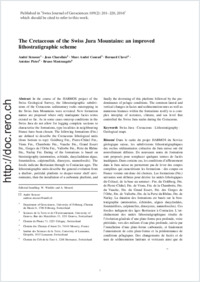The Cretaceous of the Swiss Jura Mountains: an improved lithostratigraphic scheme
- Strasser, André Department of Geosciences, University of Fribourg, Switzerland
- Charollais, Jean Sciences de la Terre et de l’Environnement, University of Geneva, Switzerland
- Conrad, Marc André Cologny, Switzerland
- Clavel, Bernard Messery, France
- Pictet, Antoine Institut des Sciences de la TerreUniversity of Lausanne, Switzerland
- Mastrangelo, Bruno Hermance, Switzerland
-
01.09.2016
Published in:
- Swiss Journal of Geosciences. - 2016, vol. 109, no. 2, p. 201–220
English
In the course of the HARMOS project of the Swiss Geological Survey, the lithostratigraphic subdivisions of the Cretaceous sedimentary rocks outcropping in the Swiss Jura Mountains were revisited. New formation names are proposed where only inadequate facies terms existed so far. As in some cases outcrop conditions in the Swiss Jura do not allow for logging complete sections to characterise the formations, type localities in neighbouring France have been chosen. The following formations (Fm.) are defined to describe the Cretaceous lithological units (from bottom to top): Goldberg Fm., Pierre-Châtel Fm., Vions Fm., Chambotte Fm., Vuache Fm., Grand Essert Fm., Gorges de l’Orbe Fm., Vallorbe Fm., Perte du Rhône Fm., Narlay Fm. Dating of the formations is based on biostratigraphy (ammonites, echinids, dasycladalean algae, foraminifera, calpionellids, dinocysts, nannofossils). The fossils indicate Berriasian through to Coniacian ages. The lithostratigraphic units describe the general evolution from a shallow, peritidal platform to deeper-water shelf environments, then the installation of a carbonate platform, and finally the drowning of this platform followed by the predominance of pelagic conditions. The common lateral and vertical changes in facies and sedimentation rates as well as numerous hiatuses within the formations testify to a complex interplay of tectonics, climate, and sea level that controlled the Swiss Jura realm during the Cretaceous.
- Faculty
- Faculté des sciences et de médecine
- Department
- Département de Géosciences
- Language
-
- English
- Classification
- Geology
- License
-
License undefined
- Identifiers
-
- RERO DOC 278443
- DOI 10.1007/s00015-016-0215-6
- Persistent URL
- https://folia.unifr.ch/unifr/documents/305224
Statistics
Document views: 116
File downloads:
- pdf: 421
